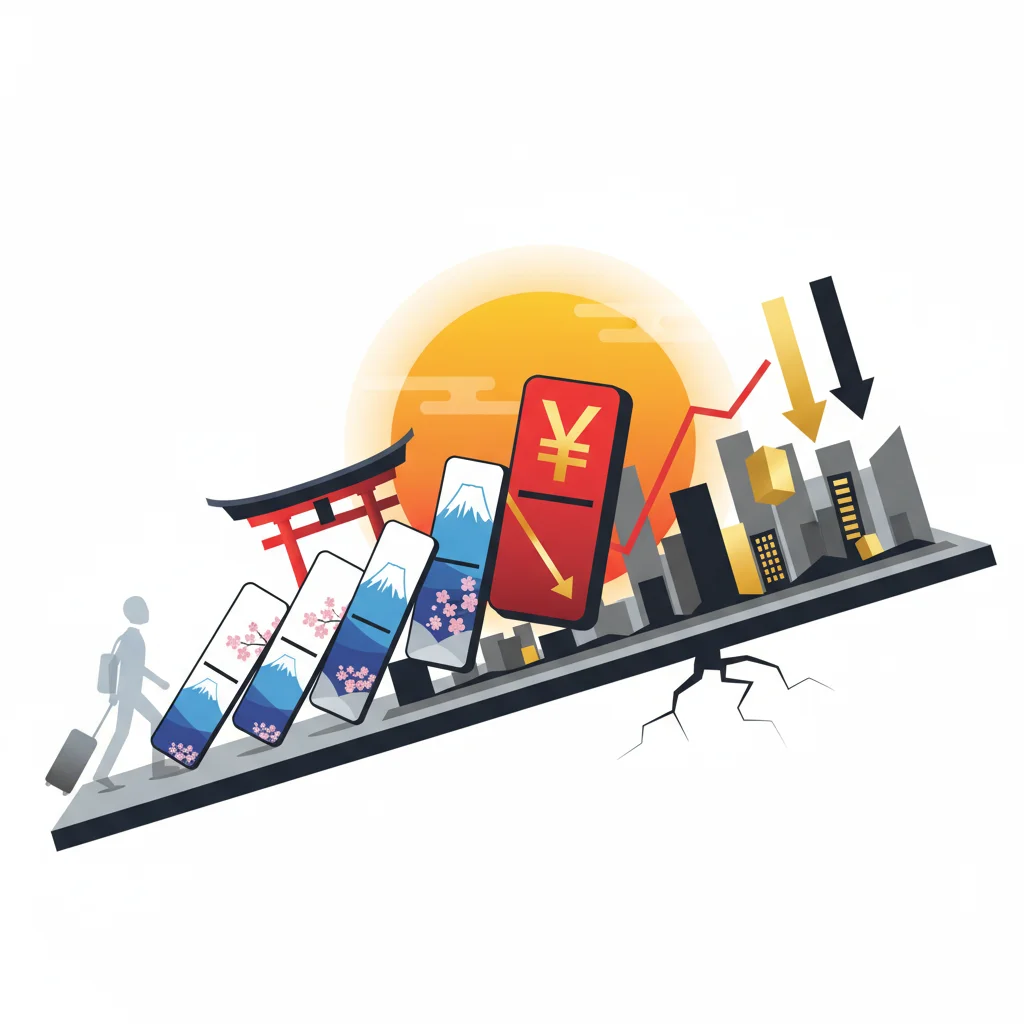
The Domino Effect: How a Tourist Slowdown is Shaking the Foundations of Japan’s Stock Market
For months, the narrative surrounding Japan’s economy was one of triumphant resurgence. After decades of stagnation, the Land of the Rising Sun was finally basking in the glow of a post-pandemic recovery. The Nikkei 225 index soared to heights not seen in over 30 years, fueled by corporate reforms, a weak yen, and, most critically, the grand reopening of its borders. The floodgates were open, and a torrent of international tourists—led by a wave of high-spending Chinese visitors—was expected to power a new era of prosperity. But as seasoned investors know, the stock market is a story of expectations, and sometimes, a single sentence can change the entire plot.
What began as a diplomatic disagreement has rapidly escalated into a tangible economic threat, sending shockwaves through the Japanese stock market. A sudden and sharp decline in Chinese tourism is forcing a painful reassessment of Japan’s growth prospects. This isn’t just about empty hotel rooms or quieter shopping streets; it’s a fundamental challenge to the recovery narrative that has captivated global finance. The story of Japan’s comeback is now facing its first major stress test, revealing the fragile link between geopolitics, consumer sentiment, and investor confidence.
The Recovery Engine Sputters: Japan’s Bet on Inbound Tourism
To understand the market’s nervous reaction, one must first appreciate the central role tourism played in Japan’s economic strategy. Before the diplomatic fallout, the government and economists alike had pinned their hopes on “inbound” consumption to drive GDP growth. The logic was simple: a weak yen made Japan an irresistibly affordable destination, and tourists, particularly from China, were known for their significant spending power on everything from luxury goods to cosmetics and electronics.
The potential was enormous. Projections suggested that a full tourism recovery could add as much as 0.7% to Japan’s real GDP (source), providing a much-needed boost to domestic demand. Companies across various sectors had reoriented their strategies to cater to this expected boom. Department stores stocked up on popular products, hotels expanded their services, and transportation companies increased capacity. The entire ecosystem of the consumer-facing economy was primed for a windfall. This optimism was priced into the stocks of these companies, which had enjoyed a significant run-up in anticipation of record profits.
The UK's £30 Billion Question: Why Labour’s Tax U-Turn Changes Everything for Investors
From Diplomatic Friction to Investor Friction
The recent diplomatic exchange of words, however, threw a wrench into these well-oiled plans. The fallout was swift, with reports of mass tour group cancellations from China and a wave of anti-Japanese sentiment spreading on social media. This sudden rerouting of tourists represents a material risk to corporate earnings, and the world of investing abhors uncertainty. Investors who had bought into the “inbound recovery” theme are now rushing for the exits.
The sell-off has been concentrated in sectors most exposed to tourist spending. The table below illustrates the direct line of impact from geopolitical tension to market valuation.
| Sector | Key Companies (Examples) | Nature of Impact |
|---|---|---|
| Retail & Department Stores | Isetan Mitsukoshi, Takashimaya | Sharp decline in duty-free sales; reduced foot traffic in flagship stores located in tourist hubs like Ginza. |
| Cosmetics & Pharmaceuticals | Shiseido, Kose, MatsukiyoCocokara | Loss of a primary consumer base for high-margin cosmetic products and popular drugstore items. |
| Hospitality & Leisure | Oriental Land (Tokyo Disney), Hoshino Resorts | Increased vacancy rates in hotels and lower attendance forecasts for major attractions. |
| Transportation | Japan Airlines (JAL), ANA Holdings | Reduced demand for international flights from China, impacting revenue and profitability on key routes. |
The market’s reaction is a classic example of forward-looking sentiment. Trading activity isn’t just reflecting current lost sales; it’s pricing in the risk that this tourism drought could be prolonged, fundamentally altering the earnings forecasts for these companies for quarters, or even years, to come. According to analysts, some retail groups derive up to 25% of their revenue from Chinese tourists alone , a figure that highlights the immense concentration risk that investors are now fleeing.
The Broader Economic Ripple Effect
The impact of this tourism shock extends far beyond the balance sheets of a few dozen companies. It poses a significant threat to Japan’s macroeconomic stability and complicates the delicate task facing the Bank of Japan.
First, it weakens a key pillar of consumption at a time when domestic demand remains fragile. With inflation outpacing wage growth, Japanese households have been cautious with their spending. Tourist expenditure was the external injection of cash needed to keep the economic engine humming. Its absence could lead to a broader slowdown, impacting employment in the service sector and dampening overall business investment.
Second, it creates a headache for monetary policy. The Bank of Japan has been patiently waiting for signs of sustainable, demand-driven inflation before it considers normalizing its ultra-loose monetary policy. A significant hit to GDP from the tourism sector could delay this process further, keeping Japan an outlier in the global banking and finance landscape. The chart below shows a simplified comparison of economic forecasts, illustrating the potential damage.
A recent poll of economists showed a marked downgrade in growth expectations, with a potential 1.2 trillion yen ($8.2 billion) wiped from annual inbound consumption if the trend continues.
The Paradox of India's Growth: Why a Booming Economy is Begging for a Spending Spree
| Economic Indicator | Previous Forecast (Full Tourism Recovery) | Revised Forecast (Prolonged Absence of Chinese Tourists) |
|---|---|---|
| Annual GDP Growth | ~2.0% | ~1.4% – 1.6% |
| Inbound Tourism Revenue | ¥5 Trillion+ | ¥3.5 – ¥4 Trillion |
| Retail Sales Growth (Y-o-Y) | +4.5% | +2.5% – 3.0% |
The Path Forward: A Mandate for Diversification and Innovation
This crisis, while painful, presents an opportunity for Japan to build a more resilient economic model. The over-reliance on a single country for tourism revenue was a vulnerability that the market has now brutally exposed. The path forward will require a multi-pronged strategy.
- Diversify Tourism Sources: Japan must aggressively market itself to travelers from other regions, including Southeast Asia, the Middle East, Europe, and North America. This involves tailoring experiences and marketing campaigns to different cultural preferences and spending habits.
- Boost Domestic Demand: The government may need to consider further fiscal stimulus or policies aimed at boosting wages to encourage domestic consumption, making the economy less susceptible to external shocks.
- Invest in New Growth Engines: This is a wake-up call to accelerate investment in other high-potential sectors. Japan has a unique opportunity to become a global leader in areas like advanced robotics, green energy, and even financial technology. Modernizing its banking sector and exploring innovations like blockchain for supply chain management could create new, more sustainable drivers of economic growth.
For investors, the landscape has shifted. The simple “buy Japan” thesis based on tourism is no longer sufficient. The focus must now turn to companies with strong domestic fundamentals, those with globally diversified revenue streams, or those poised to benefit from Japan’s next chapter of innovation.
Conclusion: A Lesson in Risk and Resilience
The sudden evaporation of Chinese tourists from Japan’s bustling cities is a powerful illustration of how quickly geopolitical events can reprice a market. It underscores a fundamental lesson in modern economics and finance: in an interconnected world, political risk is business risk. Japan’s economic recovery is not derailed, but it has been forced onto a much more challenging track. The journey ahead will test the nation’s adaptability and the ingenuity of its corporate sector. For investors, it is a crucial reminder that the most compelling stories are often the most fragile, and that true value lies in resilience, not just in rosy forecasts.


